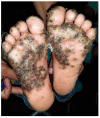Mapping the Geographic Distribution of Tungiasis in Sub-Saharan Africa
- PMID: 32722011
- PMCID: PMC7558156
- DOI: 10.3390/tropicalmed5030122
Mapping the Geographic Distribution of Tungiasis in Sub-Saharan Africa
Abstract
The geographic distribution of tungiasis is poorly understood, despite the frequent occurrence of the disease in marginalized populations of low socioeconomic status. To date, little work is available to define the geography of this neglected tropical disease (NTD). This exploratory study incorporated geostatistical modeling to map the suitability for tungiasis transmission in sub-Saharan Africa (SSA). In SSA, environmental suitability is predicted in 44 countries, including Angola, Nigeria, Ghana, Cameroon, Cote de Ivoire, Mali, Ethiopia, the Democratic Republic of the Congo, Kenya, Gabon, Uganda, Rwanda, Tanzania, Zambia, Zimbabwe, Madagascar, and South Africa. In total, an estimated 668 million people live in suitable areas, 46% (304 million) of which reside in East Africa. These evidence-based maps provide vital evidence of the potential geographic extent of SSA. They will help to guide disease control programs, inform policymakers, and raise awareness at the global level. Likewise, these results will hopefully provide decisionmakers with the pertinent information necessary to lessen morbidity and mortality in communities located in environmentally suitable areas.
Keywords: GIS; disease mapping; medical geography; neglected tropical disease; precision public health; tungiasis.
Conflict of interest statement
The author declares no conflicts of interest.
Figures







Similar articles
-
Distribution of tungiasis in latin America: Identification of areas for potential disease transmission using an ecological niche model.Lancet Reg Health Am. 2021 Nov 1;5:100080. doi: 10.1016/j.lana.2021.100080. eCollection 2022 Jan. Lancet Reg Health Am. 2021. PMID: 36776459 Free PMC article.
-
A SARS-CoV-2 Surveillance System in Sub-Saharan Africa: Modeling Study for Persistence and Transmission to Inform Policy.J Med Internet Res. 2020 Nov 19;22(11):e24248. doi: 10.2196/24248. J Med Internet Res. 2020. PMID: 33211026 Free PMC article.
-
Epidemiology of tungiasis in sub-saharan Africa: a systematic review and meta-analysis.Pathog Glob Health. 2020 Oct;114(7):360-369. doi: 10.1080/20477724.2020.1813489. Epub 2020 Sep 10. Pathog Glob Health. 2020. PMID: 32909926 Free PMC article.
-
Terrorist Attacks in Sub-Saharan Africa from 1970 through 2020: Analysis and Impact from a Counter-Terrorism Medicine Perspective.Prehosp Disaster Med. 2023 Apr;38(2):216-222. doi: 10.1017/S1049023X23000080. Epub 2023 Jan 30. Prehosp Disaster Med. 2023. PMID: 36710636
-
Predicting the environmental suitability and population at risk of podoconiosis in Africa.PLoS Negl Trop Dis. 2020 Aug 27;14(8):e0008616. doi: 10.1371/journal.pntd.0008616. eCollection 2020 Aug. PLoS Negl Trop Dis. 2020. PMID: 32853202 Free PMC article. Review.
Cited by
-
Predictive Risk Mapping of Schistosomiasis in Madagascar Using Ecological Niche Modeling and Precision Mapping.Trop Med Infect Dis. 2022 Jan 19;7(2):15. doi: 10.3390/tropicalmed7020015. Trop Med Infect Dis. 2022. PMID: 35202211 Free PMC article.
-
Characterization of tungiasis infection and morbidity using thermography in Kenya revealed higher disease burden during COVID-19 school closures.Infect Dis Poverty. 2023 Mar 21;12(1):24. doi: 10.1186/s40249-023-01080-5. Infect Dis Poverty. 2023. PMID: 36941724 Free PMC article.
-
A qualitative case study of community experiences with Tungiasis in high prevalence villages of Bungoma County, Kenya: "The whole body aches and the jiggers are torturing me!".PLoS Negl Trop Dis. 2023 Apr 26;17(4):e0011304. doi: 10.1371/journal.pntd.0011304. eCollection 2023 Apr. PLoS Negl Trop Dis. 2023. PMID: 37099605 Free PMC article.
-
Distribution of tungiasis in latin America: Identification of areas for potential disease transmission using an ecological niche model.Lancet Reg Health Am. 2021 Nov 1;5:100080. doi: 10.1016/j.lana.2021.100080. eCollection 2022 Jan. Lancet Reg Health Am. 2021. PMID: 36776459 Free PMC article.
-
Environmental and Household-Based Spatial Risks for Tungiasis in an Endemic Area of Coastal Kenya.Trop Med Infect Dis. 2021 Dec 23;7(1):2. doi: 10.3390/tropicalmed7010002. Trop Med Infect Dis. 2021. PMID: 35051118 Free PMC article.
References
LinkOut - more resources
Full Text Sources
Research Materials

